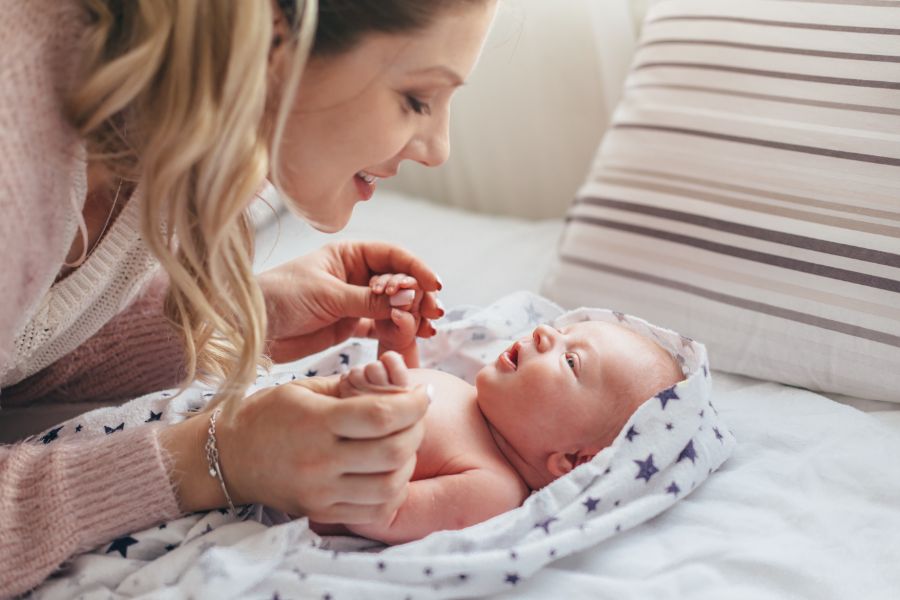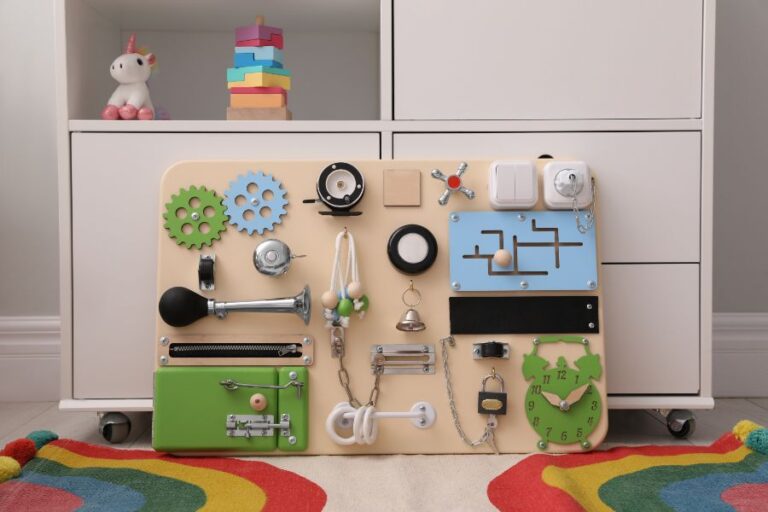Super Moms Guide to Babyproofing: Creating a Safe Environment for Your Little One
To babyproof your home, inspect every room for hazards like sharp objects or choking hazards. Install sturdy gates on stairs and lock away dangerous substances, including cleaning supplies and medication. Secure your outlets with snug-fitting covers. Opt for child-friendly furniture and blunt sharp corners. Choose cordless window coverings or use cord wraps to prevent entanglements. Guide your child's exploration, teaching potential risks without instilling fear. If you keep turning the pages of this guide, you'll discover more in-depth strategies to build an environment safe for your little one's adventures.
Main Points
- Conduct a thorough household evaluation to identify potential hazards, including hidden dangers and electrical risks.
- Install essential safety measures like sturdy metal gates and childproof locks to secure hazardous areas and substances.
- Childproof electrical outlets using snug-fitting outlet covers to eliminate the risk of electrical shocks.
- Select baby-friendly furniture with rounded corners and stable construction, and apply guards to soften sharp corners.
- Guide safe exploration for children by actively supervising their activities, teaching them about potential dangers, and establishing clear safety boundaries.
Identifying Potential Household Hazards
Starting off with the task of identifying potential household hazards, it's crucial that you conduct a thorough room-by-room evaluation, keeping an eye out for hidden dangers like sharp objects, hazardous chemicals, and lurking cords. Your childproofing mission starts in the living room, where small suffocation risks can easily be overlooked. Check for electrical hazards too, they're often neglected but can pose a real threat to curious little ones.
Next, focus on the kitchen, bathroom, and bedroom, making certain these high-traffic areas are free of any dangers. Remember, creating a hazard-free environment isn't just about responding to dangers, but proactively addressing potential risks. You're not just making the space infant-safe, you're setting up a child-friendly environment that promotes growth and exploration.
Preventive measures are your best tools in this task. Be vigilant, be thorough, and most importantly, be proactive. Your baby's safety is paramount and a consistent, room-by-room safety check can make a world of difference. With your careful attention to detail, you'll ensure that every room in your home is a safe space for your little one to learn and thrive. The work might be intense, but the peace of mind? Priceless.
Installing Essential Safety Gates
Moving on to the next critical step in babyproofing your home, it's time to tackle the installation of essential safety gates. These barriers are pivotal for child safety, preventing falls down stairs and restricting access to hazardous areas. You'll find classic metal gates effective in creating a secure environment for your little one, allowing them to explore and play safely.
Installing safety gates early on is a wise move. Sure, they may require some adjustments to your daily routine, but they offer immense peace of mind. Every time you glance at those gates, you'll know you've taken an essential step in protecting your child from potential accidents.
When installing baby gates, be meticulous. Make sure they're sturdy and properly fitted. An ill-fitted gate can lead to mishaps, defeating its purpose. And remember, gates are not just for stairs. Consider other areas that may pose a risk and need restricting access, such as the kitchen or a home office.
Securing Hazardous Substances
As a super mom, it's essential that you secure all hazardous substances in your home. Start by locking up all cleaning supplies and ensuring medications are out of reach to prevent any accidental ingestions. Remember, it's always better to be safe than sorry, so make sure to install childproof locks on any cabinets containing potentially harmful items.
Locking Up Cleaning Supplies
In the quest to forge a safer haven for your little explorer, it's essential to lock away cleaning supplies, effectively mitigating the risk of accidental exposure to hazardous substances. Start by storing all cleaning products in locked cabinets. Childproof locks are a must-have on these cabinets, especially those containing substances like bleach, detergents, and disinfectants.
In addition to locked cabinets, you can also install safety latches to prevent your child from accessing harmful chemicals and cleaning solutions. These measures not only create a safer environment for your child but also minimize the risk of accidental poisoning and chemical burns. By securing all cleaning supplies, you're taking a significant step towards babyproofing your home and ensuring that your little one grows in a safe and secure environment.
Medication Safety Measures
Just like cleaning supplies, medications also need to be securely stored out of children's reach to avoid accidental ingestion. Start by using locked cabinets for medication safety. It's an important and effective way to keep hazardous substances away. An added layer of protection is the use of childproof caps. They're specifically designed to be difficult for little hands to open, reducing the risk of your child accessing the contents. Always keep medications in their original containers with clear labels to avoid any mix-up. It's vital to dispose of expired medications promptly and correctly. Remember, education is key. Make sure everyone in the house understands the importance of these safety measures. Your diligence can prevent a frightening incident.
Childproofing Electrical Outlets
Have you considered the potential danger that electrical outlets pose to your curious little ones? It's one aspect you can't overlook when babyproofing your home. Electrical outlets, enticing to tiny fingers, are a major safety concern. You need to guarantee access to these outlets to ensure the utmost safety and protection for your children.
Outlet covers or plugs are your best bet. They fit snugly into the outlets, making them difficult for children to remove. They're not just for the living room and bedroom; they're essential for any room your child might wander into. By securing all accessible outlets, you eliminate the risk of electrical shock.
Selecting Baby-Friendly Furniture
When babyproofing your home, it's crucial to choose furniture with your little one in mind – features like rounded corners, stable construction, and non-toxic materials can make all the distinction in creating a safe environment.
Start by selecting baby-friendly furniture, designed specifically with safety features that cater to your tiny explorer. Rounded corners are a necessity; they can greatly reduce the risk of painful bumps and bruises during those first shaky steps and beyond.
The sturdy construction of furniture is non-negotiable. Choose pieces with a solid build that can withstand the curious hands of your baby. Avoid any furniture that is wobbly or unstable to prevent potential tipping accidents.
Non-toxic materials should be a top priority when selecting furniture. Many pieces, especially painted ones, can contain harmful chemicals. Opt for furniture made from natural, non-toxic substances to make sure your baby's environment is as safe as possible.
Softening Sharp Furniture Corners
As a super mom, it's crucial to guarantee your child's safety by softening sharp furniture corners. Consider opting for corner protectors, they're a simple and effective solution to minimize the risk of bumps and injuries. Moreover, don't worry, installing these safety measures is as easy as pie and we'll guide you on how to do it.
Choosing Corner Protectors
Selecting the appropriate corner protectors to soften those sharp furniture corners is an important step in safeguarding your little ones against potential injuries. When babyproofing, it's essential to choose protectors made from soft cushioned materials like foam or rubber. These materials provide a protective barrier, diffusing the impact of accidental collisions, thereby helping to prevent injuries.
Corner protectors come in a variety of shapes and sizes, so it's key to choose ones that best fit your furniture's edges. This not only enhances safety but also contributes to creating a child-friendly environment. Remember, babyproofing isn't a one-time event, but a continuous process. By integrating corner protectors, you're not just softening sharp furniture corners, but also ensuring your home remains a safe haven for your little explorers.
Easy Installation Tips
To ensure your child's safety, it's vital you know how to install corner guards correctly on your sharp furniture edges. These guards provide important cushioning for those sharp corners, preventing injuries and creating a safer exploration space for your little one. The easy installation of corner guards involves adhesive backing, which securely fastens the guard to the furniture. Start by thoroughly cleaning the furniture corner to make sure the adhesive sticks properly. Peel off the protective layer from the adhesive backing and firmly press the guard onto the corner. Hold it in place for a few seconds to make sure it's firmly adhered. By promptly softening and covering sharp furniture corners, you're building a safer environment for your child.
Ensuring Window Treatments Safety
When it comes to the safety of your little ones, you'll want to make sure that your window coverings are not just stylish but also child-friendly. Cordless blind coverings are an excellent choice, eliminating the risk of your child getting tangled in long, dangling cords. If cordless options aren't feasible, consider using cord wraps to secure blind cords, keeping them out of reach.
Window guards are another essential safety measure, especially for homes with multi-story windows. They secure your window openings, greatly reducing the chance of your child accidentally falling out.
When selecting window coverings, opt for designs that don't have long cords or tie-ups to minimize the risk of entanglement. Regularly inspect and maintain these coverings to identify and rectify any potential hazards promptly.
Ensure blinds and curtains are installed high enough to be out of reach of young, curious hands. This not only prevents accidents but also keeps your window coverings in prime condition.
Guiding Safe Exploration for Children
As a super mom, it's crucial that you actively lead your little one's exploration, closely supervising their activities to guarantee their safety and well-being. You're their guide in this vast world, and your primary role is to make sure child safety at all times. This begins with teaching them about potential dangers they may encounter. It's not about instilling fear, but about promoting awareness and preparedness.
Establish clear safety boundaries within your home and even in outdoor play areas. These boundaries will help guide your child's safe exploration, allowing them to learn and grow within a secure environment. Consistency is key here; children respond well to routines and rules that are set and followed regularly.
Encourage open communication with your little one. If they're curious or unsure about something, they should feel comfortable coming to you for guidance. This will not only strengthen your bond but will also help address any safety concerns promptly.
Lastly, role-play different safety scenarios with your child. This interactive approach can be quite effective in helping them understand how to respond to potential hazards. Remember, your goal isn't to shield them from every danger, but to equip them with the knowledge and confidence to navigate safely.




